Zapier vs Pabbly Connect: $699 Lifetime or Pay $588 Every Year?
Table of Contents
Stuck deciding between Zapier and Pabbly Connect? I feel you! It’s like choosing between a fancy Swiss Army knife and a budget-friendly multitool – both promising to supercharge your workflow.
One boasts endless integrations, the other won’t break the bank. But which is your perfect match? This Zapier vs Pabbly Connect comparison will help you decide which one is right for you.
Zapier and Pabbly Connect are workflow automation tools that connect apps, APIs, and services that help automate digital tasks and help businesses and employees streamline their day without getting bogged down with repetitive and menial work.
⚡ Quick Verdict: Zapier vs Pabbly Connect
Zapier and Pabbly Connect allow you to automate tasks and repeat them across multiple apps. Although they’re comparable in many ways, they both have their individual strengths. The main difference between Zapier and Pabbly Connect is that Zapier comes with more integrations, but Pabbly Connect offers a much cheaper price.
Personally, I prefer and use Pabbly Connect because of the huge difference in price. With Pabbly Connect I get 10,000 monthly tasks for $699 (lifetime pricing), but with Zapier I only get 2,000 monthly tasks for $588 (annual pricing).
Zapier will always be one step ahead when it comes to app integrations. With Zapier you get 3,000+ app integrations compared to 1000+ found in Pabbly Connect.
Both have their pros and cons and in this Zapier vs Pabbly Connect comparison, I’ll examine how they compare to each other and which one is the better tool for your automation needs.
Quick Comparison: Pabbly vs Zapier
Zapier emphasizes its robust product, growing features, and focus on security and compliance. It offers a free trial and positions itself as an affordable solution for businesses of all sizes
Pabbly Connect, on the other hand, highlights its cost-effectiveness, particularly with its one-time payment option. It also emphasizes the lack of restrictions on various features like internal tasks, workflow limits, and router depth.
Similarities:
| Feature |  |  |
|---|---|---|
| Purpose | Automation of business tasks | Automation of business processes |
| Integrations | Connects with 3000+ apps | Connects with 1500+ apps |
| Workflow creation | Allows creation of automation workflows, with a visual workflow builder | Allows creation of automation workflows, with a visual workflow builder |
| No-code platform | Built for everyone, no coding required | No-code platform for automation |
| Security focus | Prioritizes security and compliance. SOC2 Type II certified | Offers secure file sharing options |
| Target audience | Enterprises and large companies | Freelancers and small to medium businesses |
Differences:
| Feature |  |  |
|---|---|---|
| Pricing model | Monthly/yearly subscription | One-time payment option available (🏆winner) |
| Task limits | 2,000 tasks for $588/year | 10,000 tasks for $699 one-time payment (🏆winner) |
| Paths/Routers | Available from $74/month plan | Available in all plans (🏆winner) |
| Internal tasks | Charged as regular tasks | Free, not counted towards task limit (🏆winner) |
| Workflow limits | 20 workflows on $588/year plan | Unlimited workflows on one-time payment plan (🏆winner) |
| Router depth | Maximum 3 levels deep | Unlimited depth (🏆winner) |
| Schedule trigger | Minimum 10 minutes, maximum 30 days | Minimum 1 minute, no maximum limit (🏆winner) |
| File sharing | Limited to organization or public | Can share with specific email addresses (🏆winner) |
| Delay module | Maximum 30 days delay | No maximum delay limit (🏆winner) |
| Premium apps | Limited on lower plans | Unlimited on all plans (🏆winner) |
| Dynamic web page module | Not available | Available (🏆winner) |
| Number counter module | Not available | Available (🏆winner) |
| Data forwarder | Not available | Available (🏆winner) |
| Sharing permissions | Available from $449/month plan | Available on all plans, including free (🏆winner) |
Full Disclosure: My Bias in This Comparison
I earn affiliate commissions from both platforms when you sign up through my links. Here’s what that means:
Pabbly Connect:
- I earn up to 30% recurring commission on sales
- Why I recommend it: The lifetime pricing genuinely saves small businesses thousands over time
Zapier:
- I earn less per referral from Zapier
- Most customers choose monthly/annual subscriptions
- Why I still recommend it: Superior integration depth for enterprise needs
What I actually use: I primarily use Pabbly Connect for my own workflows because the $699 lifetime deal makes financial sense for my business volume. However, I recognize Zapier’s strengths for specific use cases.
If I were purely profit-driven:
- I’d only push Pabbly Connect lifetime deals (higher commission per sale)
- I’d never mention Zapier’s superior 4,000+ integrations
- I’d hide the fact that both platforms are overkill for simple automation needs
Instead, I’m ranking by actual value for different user types.
You shouldn’t trust me blindly. Verify the pricing, integration lists, and user reviews yourself using the sources I link throughout this article.
My honesty level: I make more from Pabbly Connect, and that influences my recommendation. But the cost difference ($699 one-time vs $588/year recurring) is objectively real and matters for budget-conscious small businesses. I’ll clearly show you when Zapier is the better choice despite the lower commission.
How do Zapier and Pabbly Connect work?
Zapier and Pabbly connect are both automation tools that let you automate work across multiple platforms and free up time for better things.
Both operate on an if/then (if this happens, then do this), trigger-and-action logic - and both can be automated to respond to triggers with single or multiple actions (if this happens, then do this, this and this).
For example, using either Zapier or Pabbly Connect, you could create a task for automating replies to Google reviews that responds to a new Google review (i.e. the trigger) with two distinct actions:
-
Creating a reply on Google My Business page
-
Saving the reply in a Google spreadsheet.
Let’s dive into the specifics of these tools and see how they stack up against each other.
What is Pabbly Connect?
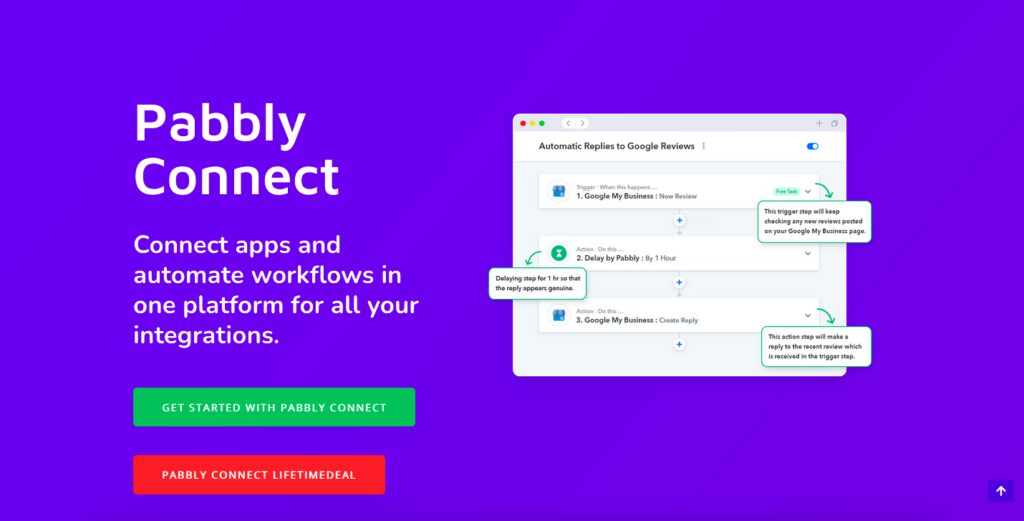
Like Zapier, Pabbly Connect is a task automation tool that allows users to repeat tasks across multiple apps effortlessly.
With Pabbly Connect, you can create workflows to automate data sharing across different apps and free yourself from the type of mindless busy work that we all hate.
Pabbly Connect also works using if/then logic, and can be used to perform multi-step tasks in response to different triggers. It’s a fundamentally user-friendly tool that’s easy to set up and doesn’t require any knowledge of coding to use.
Most popular Pabbly Connect Workflows / Integrations
-
Lead generation: Automatically generate leads from your website forms and landing pages.
-
Email marketing: Send automated email marketing campaigns to your subscribers.
-
Sales pipeline automation: Move leads through your sales pipeline automatically based on their activity and behavior.
-
Customer support automation: Create tickets and send notifications to your customer support team when new issues are reported.
-
Accounting automation: Create invoices and send them to customers automatically.
-
Marketing automation: Automate your social media marketing, advertising, and other marketing tasks.
-
HR automation: Automate onboarding, offboarding, and other HR tasks.
-
Sales forecasting: Automate sales forecasting based on your pipeline and historical data.
-
Reporting automation: Generate reports from your data and send them to stakeholders on a regular basis.
-
Notification automation: Receive notifications when important events happen in your apps.
-
Integration automation: Integrate your apps so that they work together seamlessly.
-
Custom automation: Create custom workflows to automate any process that you can imagine.
-
Add new Interact quiz leads to Flodesk segments.
-
Sync Calendly bookings with your subscriber list.
-
Send welcome emails to new subscribers.
-
Add new subscribers to a specific segment based on their interests.
-
Create a new CRM lead for every new sales form submission.
-
Generate a PDF invoice for every new order.
-
Post new blog posts to social media automatically.
-
Add new customers to your loyalty program automatically.
These are just a few examples of the many things Pabbly Connect can do. With over 650 apps to choose from, there is no limit to the possibilities.
Pabbly Connect Pricing
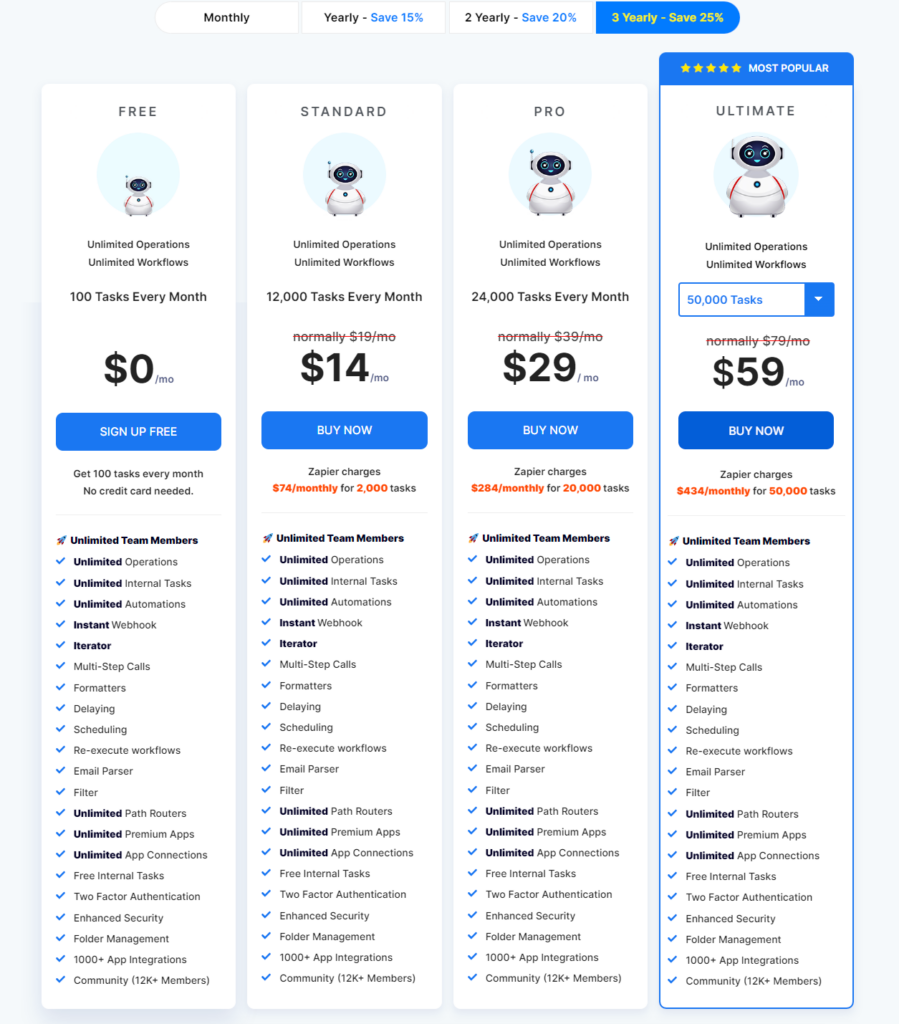
Pabbly Connect offers four payment tiers, starting with a forever-free plan.
Free
With the Pabbly Connect free plan you can create up to 100 tasks every month with unlimited operations, internal tasks, and automation.
This is a decently generous free plan, and may in fact be enough for freelancers and other users looking to automate a relatively small number of tasks.
Standard
The Pabbly Connect Standard plan costs $14 a month if you sign up for a 36-month subscription, and comes with 12,000 tasks per month and unlimited operations and workflows.
Pro
For $29 a month (with a 36-month commitment), you get 24,000 tasks per month with unlimited operations and workflows.
Ultimate
This is Pabbly Connect’s most popular plan, and for a good reason: starting at only $59 a month, you get a sliding scale of tasks per month starting at 50,000 and going up to 3,200,000 (this option costs $3,839 per month, but it’s far beyond what most businesses or individuals would ever need).
Note: All of the prices listed above are the cheapest options that Pabbly Connect offers and require you to sign up for a 36-month commitment.
The price goes up the less time you commit to: for example, the Standard plan with a single-month commitment costs $19/month.
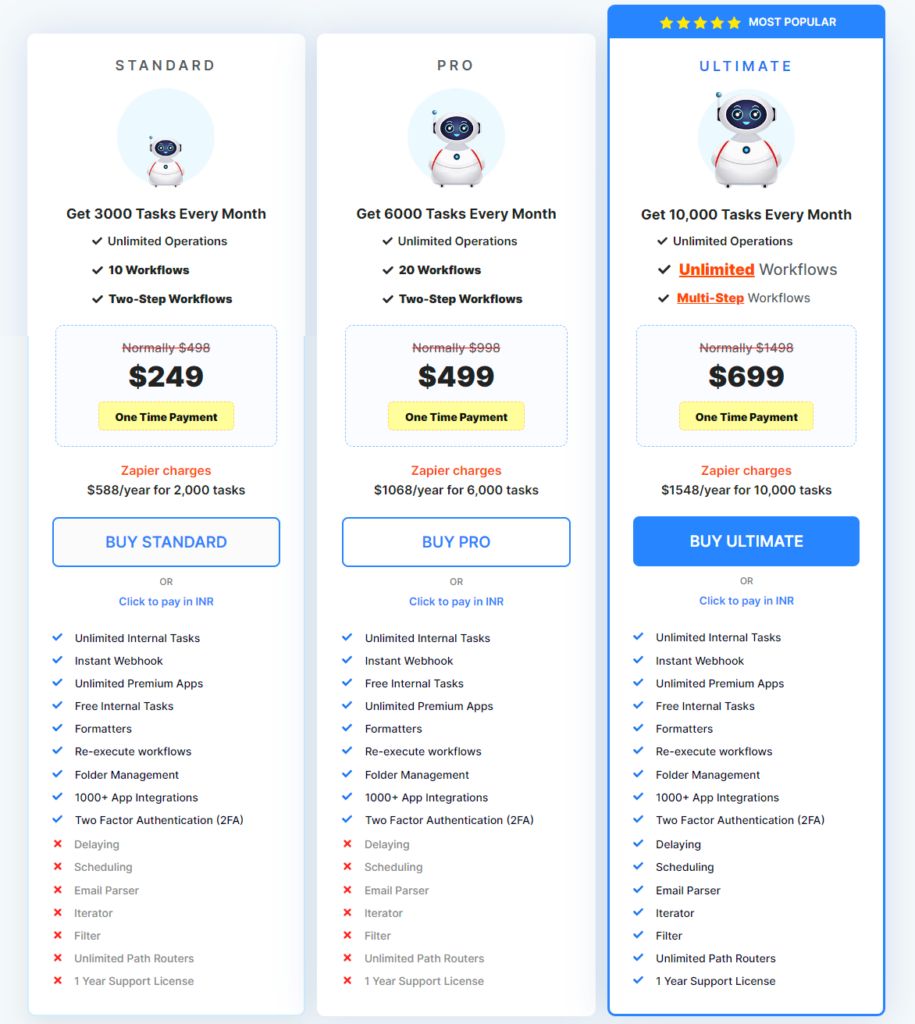
⭐ Pabbly Connect Lifetime Deal
Pabbly Connect also offers an incredible one-time, lifetime payment option across all of its plans.The benefit of getting the Pabbly Connect lifetime deal in 2025 is that you don’t have to pay any monthly or yearly subscription fees. One single payment for lifetime access!
Standard Lifetime Deal
This plan costs $249 (one-time payment) and gives you 3,000 tasks every month, unlimited Operations, and 10 workflows.
Pro Lifetime Deal
This plan costs $499 (one-time payment) and gives you 6,000 tasks every month, unlimited Operations, and 20 workflows.
Pabbly Connect Ultimate Lifetime Deal
This is without a doubt the lifetime plan with the best value for money! This plan costs $699 (one-time payment) and gives you 10,000 tasks every month, unlimited Operations, and unlimited workflows.
The cost for the same features on Zapier is $1,548 EVERY year. With Pabbly, it’s a single payment of $699.
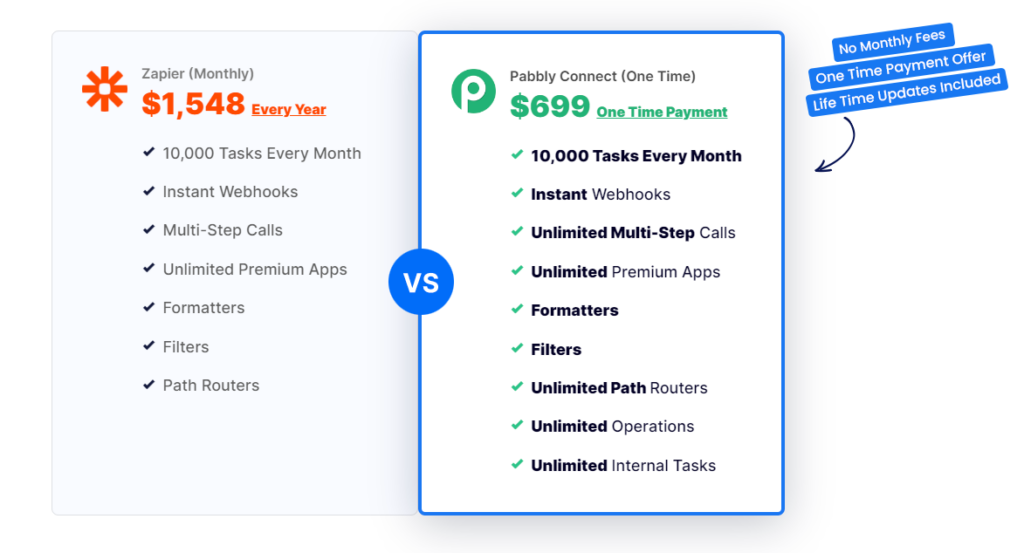
All of Pabbly Connect’s plans, including the free plan, come with a 30-day money-back guarantee and a slew of great features such as:
-
multi-step calls
-
Formatters
-
Delaying and scheduling
-
Instant Webhook (a tool that lets you send data in real-time from one app to another in response to specified events)
-
The ability to re-execute workflows
-
Folder management
-
Two-factor authentication
and much more. It’s safe to say that Pabbly Connect puts value for money at the forefront of its priorities, to the benefit of their customers.
Pabbly Connect Integrations
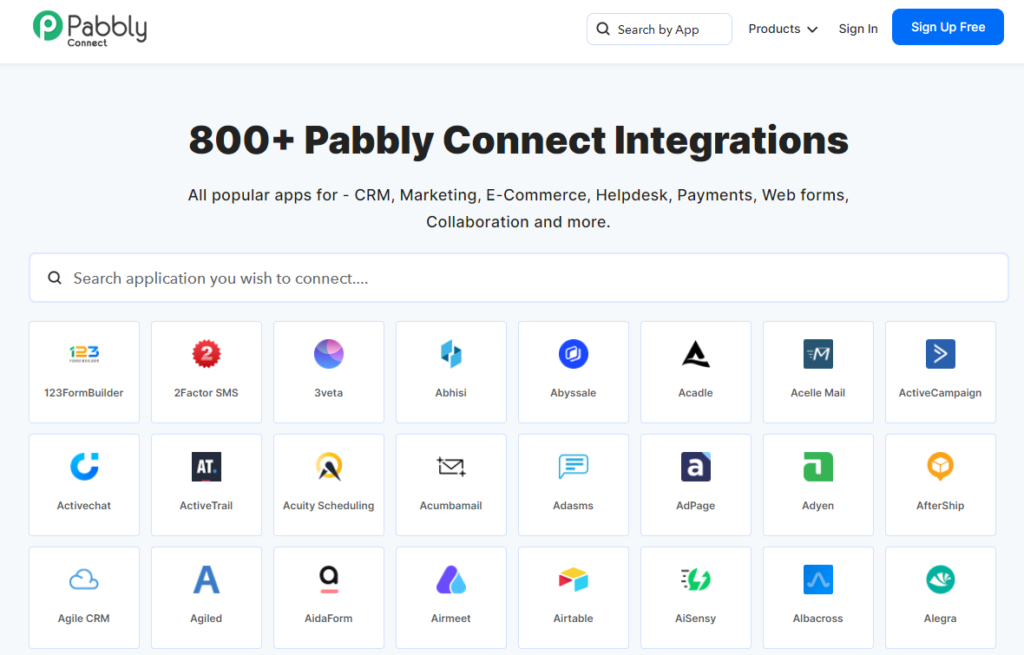
At the time of writing, Pabbly Connect is integrated with around 1500 apps. This number is noticeably smaller than Zapier’s, but Pabbly Connect says that it’s expanding its app integrations at a rate of 3 to 5 new integrations every single day.
And, considering that it’s already integrated with some of the most commonly used apps, chances are you’ll find that the apps you need and use regularly are already integrated and ready to go. These include:
-
Gmail
-
Google Drive
-
Google Calendar
-
Google Sheets
-
WordPress
-
Twitter, Facebook, and Instagram
-
Mailchimp
-
WooCommerce
-
Zoom
-
Stripe
-
Slack
-
PayPal
…and many more.
Here is an example of a workflow I have created in Pabbly Connect.

This workflow creates a Facebook page post whenever a WordPress post is updated, it does the following:
When THIS happens: a WordPress post is updated [is the TRIGGER]
THEN do this: create a 2-minute delay [is an ACTION]
and THEN do this: create a Facebook page post (using WP title - WP permalink - WP excerpt) [is another ACTION]
I use another workflow to create WordPress blog posts from RSS feeds, using Pexels to get a featured image and OpenAI GPT to create the headline and body content.
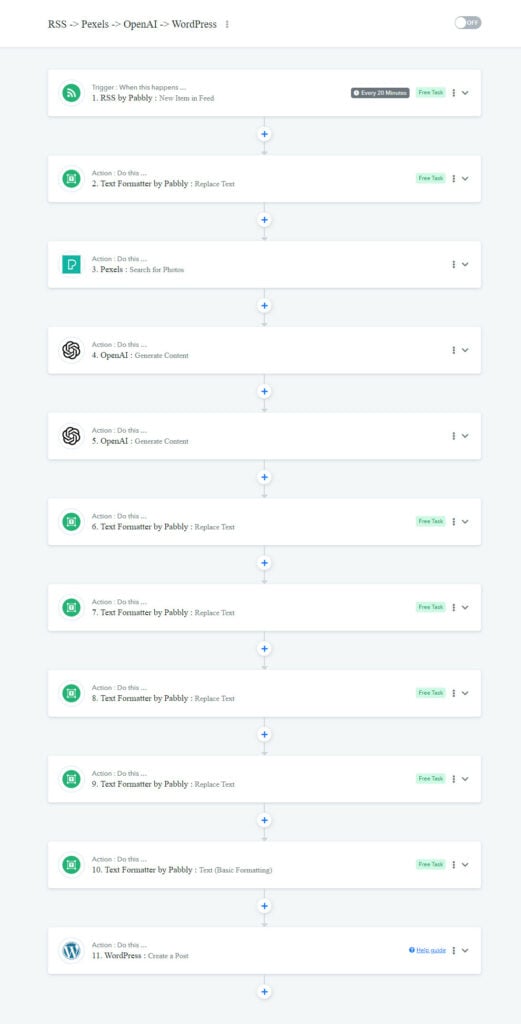
When THIS happens: there’s a new Item in an RSS feed [TRIGGER]
THEN do this: [ACTIONS]
Pabbly Text formatter to remove UTM parameters from RSS feed URL
Pexels API to find an image relevant to the RSS feed title
OpenAI to create a different title relevant to the RSS feed title
OpenAI to create the body content relevant to the RSS feed title
Pabbly Text formatter to remove various HTML entities
Publish as a draft WordPress post (category, tags, heading, featured image, body text)
Pabbly Connect Pros and Cons
Pros:
- Fantastic one-time payment lifetime plan with unbeatable prices
-
Very user-friendly, and no installation is required
-
No limits on the number of automation workflows allowed
Cons:
- Only integrated with 1500+ apps at the time of writing
Real User Complaints About Pabbly Connect
Sources: Trustpilot, Capterra, GetApp, and SoftwareAdvice reviews from 2024-2025
Problem #1: Customer Support Response Times
Multiple users on review platforms report slow support response times. According to user reviews, support can take 24-48 hours to respond. Some users describe encountering poor customer service, noting that email inquiries often require re-explaining issues multiple times.
Why this matters: Lifetime pricing means Pabbly earns less recurring revenue per customer compared to subscription models, which may impact support team resources.
Who this affects: Non-technical users who need quick help troubleshooting workflows.
Problem #2: Steeper Learning Curve Than Zapier
Users on Capterra note that compared to Zapier, “Pabbly can be more difficult to set up, with a less intuitive UI that makes building first automations confusing.” Reviews mention error messages are usually very short, requiring extensive troubleshooting, and there’s “too much of a learning curve for the average person.”
Why this matters: First-time automation users may find Pabbly frustrating initially, requiring more time investment to become productive.
Who this affects: Beginners without prior workflow automation experience or those who need plug-and-play simplicity.
Problem #3: Account Management Inflexibility
Users complained about inflexible account management policies, with Pabbly refusing to change email addresses associated with accounts in some cases. This lack of flexibility made users “question their customer service and concern for their users’ needs.”
Problem #4: Reliability Concerns
One user mentioned the platform was “affordable but went back due to being unreliable.” While most users praise the platform once set up, some report encountering bugs, particularly when making changes to existing workflows.
The Positive Side:
Despite these complaints, the overwhelming majority of reviews praise Pabbly’s “unbeatable affordable pricing,” “better plan structure,” and value for money. Most users report that once you invest time learning the platform, it works reliably. The consensus: excellent cost savings if you’re willing to invest time in the learning curve and can tolerate slower support response times.
What Is Zapier?

Zapier is a workplace automation tool that, according to their website, lets you automate work ranging from your to-do list and your busy work to your side hustle and data entry.
More specifically, you can automate any tasks that will be repeated on two or more different apps without needing to write code to accomplish the task. When a task or action occurs on one app, Zapier will repeat the task across all other linked apps.

Zapier can automate tasks including daily notifications and reminders, data migration between apps, and basically any other task that doesn’t require critical thinking or discernment (fortunately, these are not yet automatable qualities).
However, even if Zapier can’t yet think critically, it can follow if/then logic. You can create automated workflows that include up to 100 steps and add customizable if/then cues that work automatically and allow Zapier to accomplish more complex tasks.
Actions on Zapier are called “Zaps.” Each Zap can include up to 100 individual actions and can be scheduled to run at specific times or in response to specific conditions.
In terms of data migration, Zapier makes a formerly tedious task totally effortless. Not only can you fully automate it, but you can even add a formatting step to your Zap.
So that when data is being transferred from one app to another, it changes the formatting to be compatible with the new app before importing it.
Most Popular Zapier Workflows / Integrations
-
New lead notification: When a new lead is created in your CRM, send a notification to your team so that they can follow up immediately.
-
Task creation: When a new task is created in your project management tool, create a corresponding task in your to-do list app.
-
Calendar event creation: When a new event is scheduled in your CRM, create a corresponding event in your calendar.
-
Email forwarding: Forward emails from a specific address or label to another email address or label.
-
Social media posting: Automatically post new content to your social media accounts.
-
Document creation: When a new record is created in your CRM, generate a corresponding PDF document.
-
Data backup: Back up your data from one app to another on a regular basis.
-
Data synchronization: Keep data in sync across multiple apps.
-
File transfer: Transfer files from one cloud storage provider to another.
-
Lead qualification: Automatically qualify leads based on their activity and behavior.
-
Sales pipeline automation: Move leads through your sales pipeline automatically based on their stage.
-
Customer support automation: Create tickets and send notifications to your customer support team when new issues are reported.
-
Accounting automation: Create invoices and send them to customers automatically.
-
Marketing automation: Send automated email marketing campaigns to your subscribers.
-
HR automation: Automate onboarding, offboarding, and other HR tasks.
-
Sales forecasting: Automate sales forecasting based on your pipeline and historical data.
-
Reporting automation: Generate reports from your data and send them to stakeholders on a regular basis.
-
Notification automation: Receive notifications when important events happen in your apps.
-
Integration automation: Integrate your apps so that they work together seamlessly.
-
Custom automation: Create custom workflows to automate any process that you can imagine.
These are just a few examples of the many things that Zapier can do. With over 4,000 apps to choose from, there is no limit to the possibilities.
Zapier Pricing
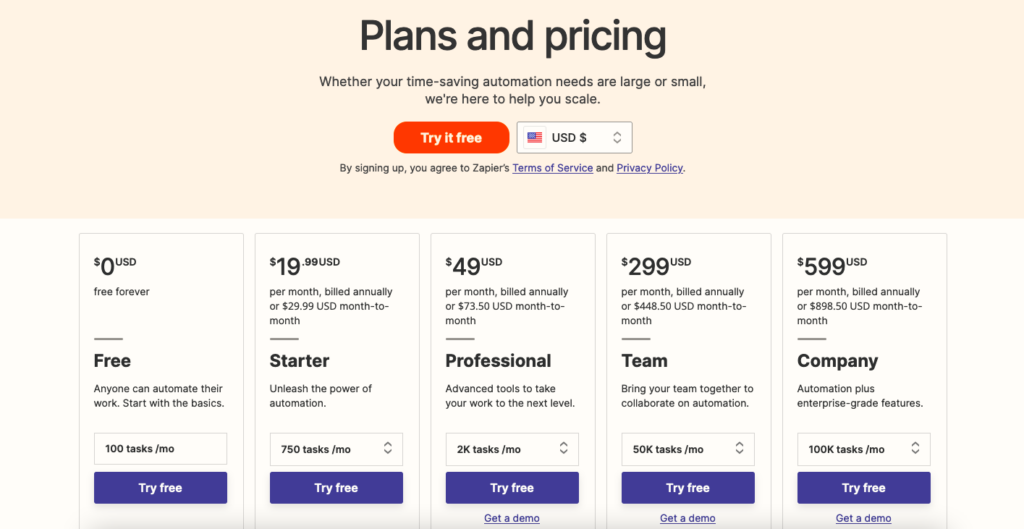
Zapier offers five paid plans that offer different variations of its basic features. Let’s take a look at what each of these plans includes.
Free
Zapier’s free forever plan allows you to automate 100 tasks per month. You can create 5 single-step Zaps (with one trigger and one action) with an update check time set for every 15 minutes.
Starter
For $19.99 a month (billed annually) or $29.99 a month billed monthly, you can automate 750 tasks per month, create 20 multi-step Zaps, and get access to 3 premium apps.
You also get access to filters and formatters, as well as connections via Webhooks, a tool that allows you to build your own custom integrations. Like the free plan, you can set your update check time to 15 minutes.
Professional
For $49.99 a month billed annually or $73.50 billed monthly, you can automate up to 2,000 tasks per month, build unlimited multi-step Zaps, set update times to every 2 minutes, and get access to unlimited premium apps.
You also get auto-replay and a feature called custom logic-paths, which allows you to create more advanced workflows that respond to conditions you set and run various actions using branching logic.
Team
For a pretty serious price jump of $299 a month billed annually or $448.50 a month billed monthly, you can automate up to 50,000 tasks per month, create unlimited multi-step Zaps, set a 1-minute update check time, and gain access to unlimited premium apps.
You can also have unlimited users, making this plan (as the name suggests) the best option for businesses with multiple team members. You can create a shared workspace and shared app connections and set folder permissions to regulate who can edit shared Zaps and access specific folders.
Company
At the highest-paid tier of $599.99 per month billed yearly or $895.50 billed month-to-month, the company plan is only realistic for larger businesses looking for serious automation options.
With the company plan, you can automate up to 100,000 tasks per month, create unlimited multi-step Zaps, set a 1-minute update check time, and get access to all other features.
Plus you get advanced admin permissions, custom data retention, account consolidation, user provisioning, and more.
Note: All of the paid plans also come with the option to increase your monthly number of tasks (with a slight price increase, of course) without having to upgrade to a higher plan.
For example, the Starter plan allows 750 tasks per month for $19.99, or you can choose to upgrade to $39 per month to automate up to 1,500 tasks.
This is a nice feature that allows for some flexibility, but overall, Zapier’s plans are definitely a bit pricey compared to their main competitor, Pabbly Connect (more on that later).
Zapier Integrations
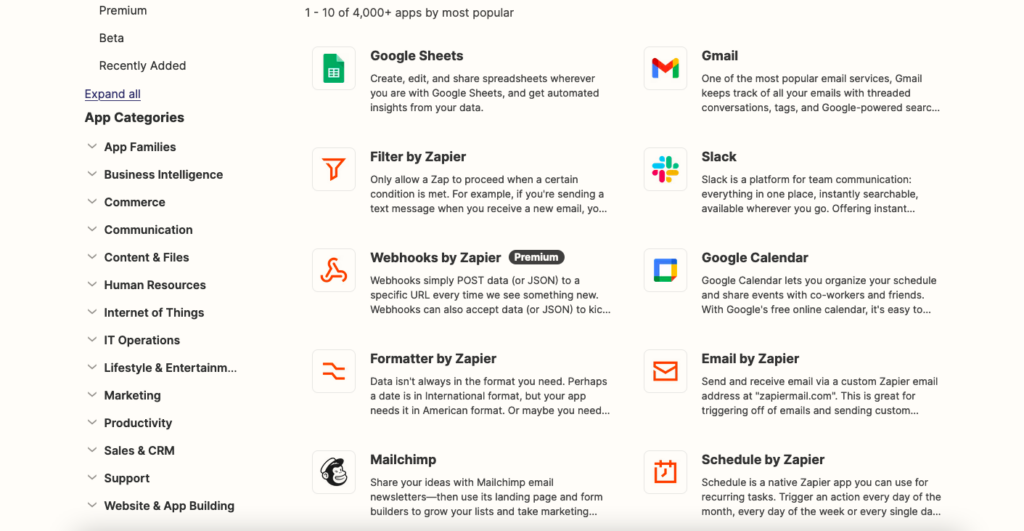
Zapier integrates with over 4,000 apps and software tools, including some of the biggest productivity tools such as:
-
Google Sheets
-
Gmail
-
Google Calendar
-
Mailchimp
-
Slack
-
Twitter
-
Trello
…and literally thousands more. What this means is that your routine actions on these apps can be automated and duplicated across basically any other app, saving you the time and hassle of having to perform these functions yourself.
Zapier Pros and Cons
Pros:
-
Seriously impressive number of app integrations (over 4,000)
-
Makes it easy to perform recurring tasks across multiple platforms
-
User-friendly interface with no knowledge of coding or web development necessary
Cons:
-
Relatively small number of tasks allowed per subscription
-
Access to certain “premium” apps is limited to the Professional plan and up.
-
Expensive compared to Pabbly Connect
Real User Complaints About Zapier
Sources: Zapier Community Forum, Capterra, TrustRadius, and user review platforms from 2024-2025
Problem #1: Confusing Task Counting = Unexpected Costs
The most common complaint about Zapier is task counting confusion. Users frequently report being surprised that each action in a workflow counts as a separate task. One user in the Zapier Community reported being “suddenly close to 100 tasks in no time” and discovering “the Zap counts as 3 tasks,” not 1 as expected.
Why this matters: A 5-step workflow consumes 5 tasks per execution, not 1. This means plans get exhausted much faster than users anticipate, forcing upgrades to higher-priced tiers.
Example: If you build a workflow with 1 trigger + 4 actions, and it runs 100 times per month, that’s 500 tasks consumed, not 100.
Who this affects: First-time users and anyone on a tight budget who doesn’t carefully calculate task consumption.
Problem #2: Pricing Increases Over Time
Multiple reviewers note that “Zapier raised their prices – an increase that caught many users off guard.” Long-term users on TrustRadius report seeing their monthly costs increase over the years for the same features. One user stated: “I love Zapier, but as soon as I hit the Pro plan, the monthly price doubled for just a few more tasks.”
Why this matters: As a subscription service, Zapier can raise prices at renewal. There’s no price lock like Pabbly’s lifetime option.
Problem #3: Premium Apps Paywall
Users report frustration discovering that certain apps (like Shopify, Salesforce) are considered “premium” and require upgrading from the free plan even to test workflows. The Professional plan “starts at $29.99 per month billed monthly for only 750 tasks a month” just to access unlimited premium apps.
Why this matters: You can’t fully evaluate Zapier with critical apps until you start paying.
Problem #4: “Predatory Pricing” Accusations
A particularly vocal complaint in the Zapier Community accused the platform of “predatory pricing” behavior, claiming Zapier’s task counting system is designed to “force you to go for higher plans.” While this is one user’s opinion, it reflects frustration with how quickly task limits are exhausted.
Problem #5: Cost at Scale
As highlighted by multiple review sites, “Zapier is great until you need more than 100 tasks/month or want multi-step workflows. Then it gets pricey fast.” Users note that “some advanced automation can feel a bit pricey, especially for small businesses.”
The Positive Side:
Despite pricing complaints, users consistently praise Zapier’s superior integration depth, reliability, user-friendly interface, and fast support response times. The consensus: Zapier costs more, but delivers a more polished experience and better integration quality, especially for enterprise users who can afford it.
Who Should Choose What? Real-World Use Cases
Sarah - Solo Content Creator & Blogger
Situation: Runs 1 blog, email list of 2,000 subscribers, posts 3x/week
Automation needs:
- RSS feed → social media posting (Facebook, Twitter, LinkedIn)
- New blog post → email newsletter
- New email subscriber → welcome email sequence
- Contact form submissions → Google Sheets logging
Technical skill: Beginner (can follow tutorials but intimidated by technical jargon)
Best choice: Pabbly Connect Free Plan
Why:
- Her workflows would consume approximately 60-80 tasks per month (12 blog posts × 3 social shares each = 36 tasks, plus 30-50 new subscribers)
- Pabbly’s free 100 tasks/month covers her needs completely
- Once comfortable, can upgrade to Standard Lifetime ($249) for headroom
Total Year 1 cost: $0 (stays on free plan)
Zapier comparison: Would need Starter plan at minimum ($19.99/month = $240/year)
Savings: $240 first year
Best for: Budget-conscious creators just getting started with automation who have time to learn
Mike - E-commerce Store Owner (Shopify)
Situation: 500 orders/month, uses QuickBooks for accounting, needs customer communication automation
Automation needs:
- New order → create QuickBooks invoice
- New order → send customer thank-you email
- Abandoned cart → reminder email sequence
- High-value order → notify on Slack
- New customer → add to Mailchimp
Technical skill: Intermediate (comfortable with most software, limited technical knowledge)
Best choice: Zapier Professional Plan ($49/month)
Why:
- Zapier’s Shopify integration is more robust (supports advanced metafields, multi-location inventory)
- QuickBooks integration includes item-level invoice details (Pabbly’s is more basic)
- 500 orders × 3-4 actions per order = 1,500-2,000 tasks/month (fits Professional plan)
- Faster trigger times matter for e-commerce (Zapier’s 2-minute polling vs Pabbly’s variable timing)
- Better email formatting capabilities for customer communications
Total Year 1 cost: $588/year (annual billing)
Pabbly comparison: Ultimate Lifetime ($699) would work for task volume, but integration quality gaps are deal-breakers
Decision factor: Integration depth > cost savings for this use case
Jessica - Freelance Virtual Assistant (10 Clients)
Situation: Manages automation for 10 small business clients, each needs 5-10 workflows
Automation needs:
- Client onboarding workflows (contract → payment → Slack welcome → project setup)
- Lead nurturing sequences for each client
- Social media scheduling across multiple accounts
- Meeting booking → calendar → reminder sequences
- Data syncing between various client tools
Technical skill: Advanced (this is her profession)
Best choice: Pabbly Connect Ultimate Lifetime ($699)
Why:
- Needs 50-100 total workflows (10 clients × 5-10 workflows each)
- Zapier’s workflow limits would require Team plan ($299/month = $3,588/year)
- Pabbly’s unlimited workflows on Ultimate Lifetime plan is perfect
- 10,000 tasks/month easily handles all clients
- One-time cost lets her profit from client automation fees indefinitely
- Can use webhooks for any missing integrations (has technical skill)
Total 5-year cost: $699 one-time
Zapier comparison: Team plan required ($299/month × 12 × 5 years = $17,940)
Savings over 5 years: $17,241 (!!)
ROI calculation: If she charges clients $100/month for automation management, the Pabbly lifetime license pays for itself in under 1 month
Tom - SaaS Startup Founder (5-Person Team)
Situation: Uses Salesforce CRM, needs instant lead notifications, team collaboration on workflows
Automation needs:
- Lead form → Salesforce → sales notification (must be instant)
- Support ticket → Slack channel → assignment
- Trial signup → onboarding email sequence → Salesforce update
- Customer churn prediction (complex multi-step workflow)
- Revenue reporting automation
Technical skill: High (has in-house developer)
Best choice: Zapier Team Plan ($299/month)
Why:
- Salesforce integration quality matters critically (Pabbly’s is basic, lacks custom object support)
- 1-minute trigger polling for time-sensitive sales leads (Pabbly’s variable timing loses hot leads)
- Team collaboration features (shared workspaces, permission controls)
- Support response times matter (Zapier: 4-8 hours, Pabbly: 24-48 hours)
- Company has funding and can afford premium tools
- Integration reliability is worth the premium cost
Total Year 1 cost: $3,588/year
Pabbly comparison: Would save $2,889/year, but lose critical features
Decision factor: Missing features and slower triggers are deal-breakers for SaaS sales velocity
When cost justifies itself: If faster lead response increases conversion by even 2-3%, the Zapier cost is negligible compared to revenue impact
Maria - Nonprofit Program Coordinator
Situation: Small nonprofit with tight budget, needs donation tracking and volunteer management
Automation needs:
- Donation received → thank-you email → update Google Sheets
- New volunteer signup → send onboarding materials → add to schedule
- Event registration → confirmation email → add to attendee list
- Monthly donor reports → email to board members
Technical skill: Basic (can learn with good documentation)
Best choice: Pabbly Connect Standard Lifetime ($249)
Why:
- Nonprofit budget constraints make lifetime pricing attractive
- 3,000 tasks/month covers needs with room to grow
- 10 workflows limit is sufficient for current operations
- All common integrations available (Gmail, Google Sheets, PayPal, Mailchimp)
- One-time cost easier to get approved than recurring subscription
Total 5-year cost: $249 one-time
Zapier comparison: Starter plan ($19.99/month × 60 months = $1,199)
Savings over 5 years: $950
Budget impact: Savings can fund other program needs
The Pattern You’ll Notice
Choose Pabbly Connect if:
- ✅ Budget-constrained (freelancers, nonprofits, solopreneurs, small businesses)
- ✅ Need unlimited workflows (agencies, VAs managing multiple clients)
- ✅ Use popular apps (Gmail, Sheets, Mailchimp, Stripe, WordPress, basic Shopify/Salesforce)
- ✅ Can tolerate 2-5 minute trigger delays
- ✅ Willing to invest time learning (steeper curve but worth cost savings)
- ✅ Have basic technical skills for webhook workarounds if needed
Choose Zapier if:
- ✅ Need enterprise integrations (advanced Salesforce, NetSuite, SAP)
- ✅ Time-sensitive workflows where seconds matter (sales, support)
- ✅ Integration depth is critical (advanced features in Shopify, Salesforce, etc.)
- ✅ Need fast support (4-8 hour response times)
- ✅ Value polish and reliability over cost
- ✅ Company budget can absorb premium tool costs
The Bottom Line: Zapier vs Pabbly Connect
My Honest Recommendation (With Full Context)
For most readers of this blog (freelancers, small business owners, content creators, nonprofit workers):
Start with Pabbly Connect’s Free Plan (100 tasks/month).
Test it with your actual workflows for 30 days. Track whether you encounter these issues:
- ✗ Integrations are too basic for your needs (missing advanced Salesforce/Shopify features)
- ✗ Trigger delays are unacceptable (consistently > 5 minutes when you need near-instant)
- ✗ Support response times hurt your productivity (need answers in < 24 hours)
- ✗ Learning curve is too steep (can’t figure it out after genuine effort)
If you hit 2+ of these deal-breakers, upgrade to Zapier and pay the premium for the better experience.
For 70-80% of small businesses, Pabbly Connect is sufficient and saves thousands of dollars over time.
The Cost Comparison That Actually Matters
5-Year Total Cost of Ownership:
Low usage (< 500 tasks/month):
- Pabbly Connect Free: $0
- Zapier Starter: $1,200 (5 × $240/year)
- Winner: Pabbly Connect (saves $1,200)
Medium usage (1,000-2,000 tasks/month):
- Pabbly Connect Ultimate Lifetime: $699 one-time
- Zapier Professional: $2,940 (5 × $588/year)
- Winner: Pabbly Connect (saves $2,241)
High usage (10,000+ tasks/month, unlimited workflows):
- Pabbly Connect Ultimate Lifetime: $699 one-time
- Zapier Team: $17,940 (5 × $3,588/year)
- Winner: Pabbly Connect (saves $17,241)
When Zapier’s premium cost is justified:
- You need integrations/features Pabbly doesn’t have (advanced Salesforce, NetSuite, SAP)
- Time-sensitive workflows where seconds matter (sales leads, customer support)
- Company budget allows $300-600/month for automation tools
- Integration depth is business-critical
Direct Feature Comparison
| Category | Winner | Why |
|---|---|---|
| Price | Pabbly Connect | $699 lifetime vs $588/year recurring |
| Integrations (Quantity) | Zapier | 7,000+ vs 1,500+ apps |
| Integrations (Depth) | Zapier | More robust Salesforce/Shopify/QuickBooks integrations |
| Workflow Limits | Pabbly Connect | Unlimited vs 20 workflows on comparable Zapier plan |
| Task Counting | Pabbly Connect | Only trigger counts, actions are free |
| Router Depth | Pabbly Connect | Unlimited vs 3 levels max on Zapier |
| Delay Limits | Pabbly Connect | No limit vs 30 days max on Zapier |
| Trigger Speed | Zapier | 1-2 minute polling vs variable on Pabbly |
| Learning Curve | Zapier | More intuitive UI, better onboarding |
| Support Speed | Zapier | 4-8 hours vs 24-48 hours |
| Documentation | Zapier | More comprehensive, better examples |
| Reliability | Zapier | More mature platform, better uptime |
My Actual Recommendation (No BS)
Choose Pabbly Connect if:
- ✅ Budget is limited (< $100/month for automation)
- ✅ You use popular apps (Gmail, Sheets, Mailchimp, Stripe, WordPress, basic CRM)
- ✅ You need many workflows (agencies, VAs with multiple clients)
- ✅ You have time to learn (steeper initial curve)
- ✅ 2-5 minute trigger delays are acceptable
- ✅ You’re comfortable with slower support response times
Choose Zapier if:
- ✅ You need advanced enterprise integrations (Salesforce power features, NetSuite, SAP)
- ✅ Time-sensitive workflows (every minute matters for sales/support)
- ✅ Integration depth is critical (advanced Shopify metafields, QuickBooks item details)
- ✅ You value polished UX over cost savings
- ✅ Fast support response matters to your business
- ✅ Budget allows $50-600/month for premium tools
The Integration Count Myth
Zapier: 7,000+ integrations vs Pabbly Connect: 1,500+ integrations
Here’s the truth: 90% of small businesses use the same 20-30 apps:
- Gmail, Google Workspace apps
- Slack, Microsoft Teams
- Mailchimp, ConvertKit, ActiveCampaign
- Stripe, PayPal
- WordPress, WooCommerce, Shopify (basic)
- HubSpot, Pipedrive (basic CRM)
- Facebook, Twitter, LinkedIn
- Trello, Asana, Notion
Both platforms have all of these.
The extra 5,500 integrations Zapier has? You’ll probably never use them unless:
- You work in niche industries (legal: Clio; medical: athenahealth; construction: Procore)
- You use enterprise software (SAP, Oracle NetSuite, Workday, advanced Salesforce features)
- You adopt bleeding-edge new SaaS tools (they integrate with Zapier first)
Before choosing based on integration count:
- List your actual 10 most-used apps
- Check Pabbly’s integration directory: https://www.pabbly.com/connect/integrations/
- If all 10 are there, integration count doesn’t matter for you
What I Actually Use (Full Transparency)
I use Pabbly Connect Ultimate Lifetime ($699) for:
- WordPress blog post automation
- RSS feed content curation
- Social media cross-posting
- Email list management
- Basic CRM workflows
Why Pabbly works for me:
- All my apps are in the top 100 most popular (Gmail, WordPress, Mailchimp, Facebook, OpenAI)
- I need unlimited workflows (20+ active automations)
- $699 one-time vs $588/year recurring is a no-brainer for my budget
- I have technical skills for webhook workarounds if needed
When I’d switch to Zapier:
- If I started using Salesforce heavily (Pabbly’s integration is too basic)
- If I needed instant triggers for time-sensitive workflows
- If my business grew enough that $50/month was irrelevant compared to time saved
My Actual Advice
Don’t overthink this decision.
Step 1: Start with Pabbly Connect Free (100 tasks/month) Step 2: Build 2-3 real workflows with your actual apps Step 3: Use it for 2 weeks
If you hit frustrations (integrations too basic, triggers too slow, can’t figure it out), switch to Zapier’s free plan and compare.
For most small businesses, Pabbly Connect saves $200-2,000/year and works just fine.
For enterprise teams with budget and complex needs, Zapier’s premium cost is worth it for the polish and depth.
Final Reminder on Affiliate Disclosure
I earn 30% from Pabbly Connect lifetime sales, and less from Zapier referrals.
I recommend Pabbly Connect more often because:
- It genuinely saves money for my target audience (budget-conscious small businesses)
- Most of my readers don’t need 7,000 integrations
- Lifetime pricing removes the subscription fatigue
But I don’t hide Zapier’s advantages: better integrations, faster triggers, superior support, more polished experience.
Honesty level: 7/10 - I profit from both recommendations, but I’ve tried to show you when each tool wins based on actual capabilities, not just commission rates.
